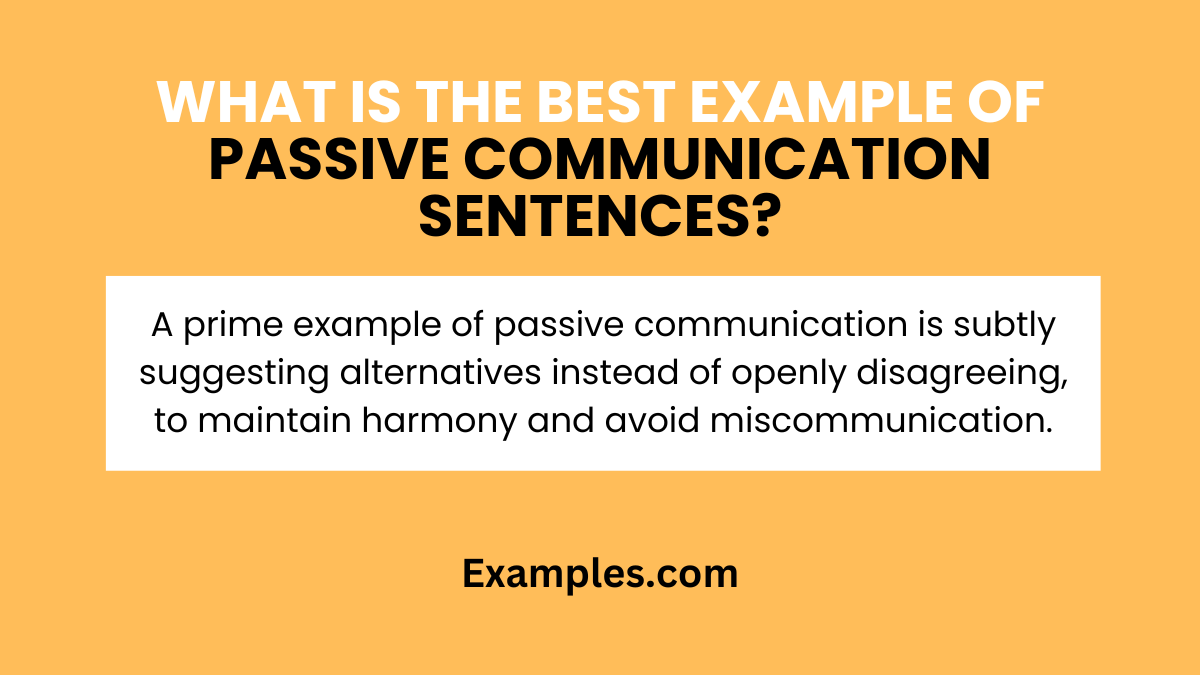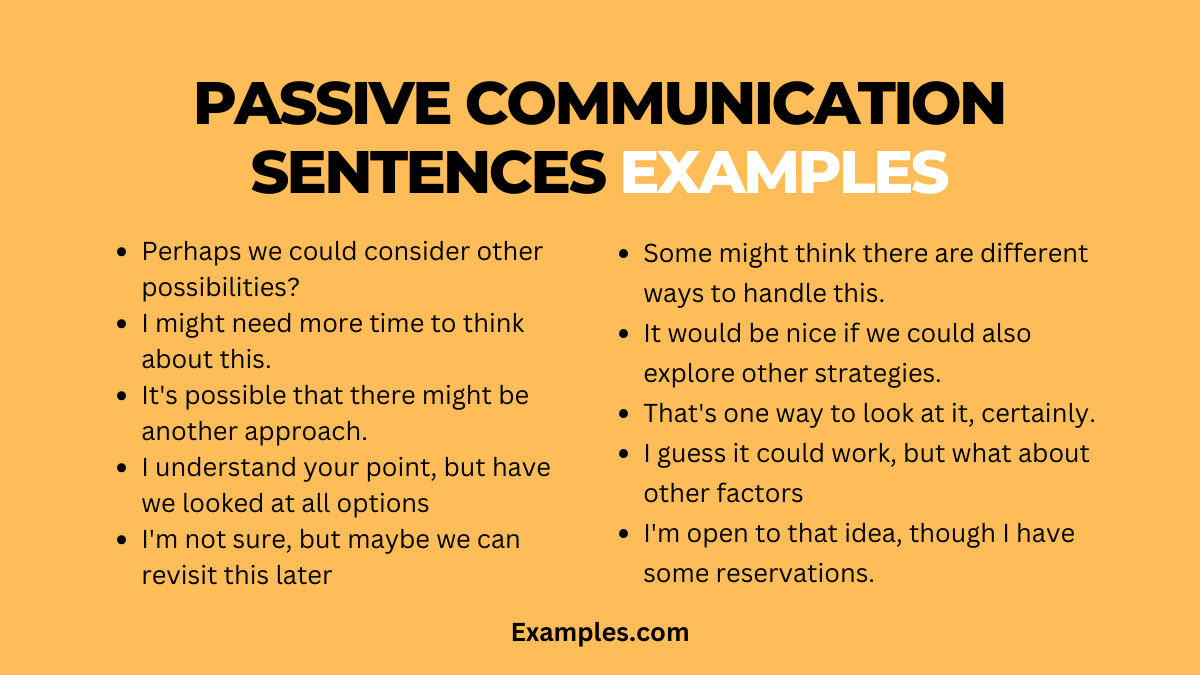Passive Communication Sentences
Passive Communication Sentences offer a subtle, often understated way of expressing oneself, which can be particularly therapeutic in sensitive situations. This guide provides a thorough exploration of such sentences, showcasing how they can be used effectively in various contexts. Whether it’s in personal relationships or professional environments, mastering these sentences can enhance your Communication Skills and Nonverbal Communication, fostering a more harmonious and empathetic atmosphere. Through practical examples and tips, this guide will help you integrate these skills seamlessly into your daily communications.
What is the Best Example of Passive Communication Sentences?

The best examples of Passive Communication Sentences typically involve indirect or softened statements that convey a message without direct assertion. For instance, instead of saying, “I disagree with your plan,” a passive communication approach would be, “Have you considered other options that might also work well?” This method allows the speaker to express a differing opinion or concern without directly opposing the other person, which can be particularly effective in maintaining positive Interpersonal Communication and preventing Miscommunication.
15 Passive Communication Sentences Examples

- “Perhaps we could consider other possibilities?”
Suggesting alternatives indirectly instead of outright rejection.
Example: “Perhaps we could consider other possibilities for the project?” - “I might need more time to think about this.”
Expressing hesitation or the need for additional time in a non-confrontational way.
Example: “I might need more time to think about this before giving my final decision.” - “It’s possible that there might be another approach.”
Offering a different perspective without dismissing the current one.
Example: “It’s possible that there might be another approach we haven’t considered yet.” - “I understand your point, but have we looked at all options?”
Acknowledging someone’s viewpoint while gently introducing your own concerns.
Example: “I understand your point, but have we looked at all options?”
- “I’m not sure, but maybe we can revisit this later?”
Expressing uncertainty with an open-ended suggestion for future discussion.
Example: “I’m not sure, but maybe we can revisit this later?” - “Some might think there are different ways to handle this.”
Indirectly introducing a differing opinion by referring to unnamed others.
Example: “Some might think there are different ways to handle this issue.”

- “It would be nice if we could also explore other strategies.”
Proposing additional strategies in a polite, non-demanding manner.
Example: “It would be nice if we could also explore other strategies for the campaign.” - “That’s one way to look at it, certainly.”
Acknowledging someone’s perspective while leaving room for other views.
Example: “That’s one way to look at it, certainly. Are there other viewpoints we should consider?” - “I guess it could work, but what about other factors?”
Tentatively agreeing while raising additional considerations.
Example: “I guess it could work, but what about other factors we haven’t discussed?” - “I’m open to that idea, though I have some reservations.”
Showing openness while subtly expressing concerns.
Example: “I’m open to that idea, though I have some reservations about its feasibility.”

- “That seems interesting; I wonder if there are similar examples.”
Showing interest with a hint of seeking further information or alternatives.
Example: “That seems interesting; I wonder if there are similar examples we can look at.” - “Maybe we should think about it a bit more?”
Suggesting further deliberation in a non-forceful way.
Example: “Maybe we should think about it a bit more before deciding?” - “It’s an option, but let’s keep our minds open to others.”
Recognizing a possibility while encouraging consideration of additional ideas.
Example: “It’s an option, but let’s keep our minds open to others that might arise.” - “I hear what you’re saying, but could we also look at this angle?”
Validating the other person’s statement while gently steering the conversation.
Example: “I hear what you’re saying, but could we also look at this angle?” - “Your idea has merit; I’m just wondering about the implications.”
Complimenting an idea while cautiously raising questions about its impact.
Example: “Your idea has merit; I’m just wondering about the implications of implementing it.”
Passive Communication Sentences Examples in the Workplace
- “Would it be possible to discuss this further at our next meeting?”Proposing a later discussion to allow time for consideration.Example: “Would it be possible to discuss this further at our next meeting, so everyone has time to prepare?”
- “I think your point might have some validity, let’s explore it more.”Gently affirming a colleague’s point while suggesting deeper exploration.Example: “I think your point might have some validity, let’s explore it more in detail.”
- “I’m not completely certain, but we could consider your suggestion.”Expressing uncertainty while being open to a colleague’s idea.Example: “I’m not completely certain, but we could consider your suggestion for the project.”
- “It’s an interesting perspective; maybe we should get more input?”Acknowledging an idea’s worth and suggesting collective input.Example: “It’s an interesting perspective; maybe we should get more input from the team?”
- “Perhaps we should weigh the pros and cons of this approach?”Suggesting a balanced evaluation of an idea without outright rejection.Example: “Perhaps we should weigh the pros and cons of this approach before finalizing?”
Why do People Use Passive Communication Sentences?
- To Maintain Harmony: In scenarios where maintaining a peaceful atmosphere is crucial, such as in Family Communication or with friends, passive sentences help avoid confrontations, making the interaction more Therapeutic.
- To Express Diplomatically: In sensitive situations, particularly in Health Communication or during Performance Reviews, passive communication allows for the expression of opinions or feedback in a more diplomatic and less direct manner.
- To Reduce Conflict: In conflict-prone environments, like in Team Communication or during Negotiations, using passive sentences can be a method to de-escalate potential disputes and foster a more Empathetic Communication style.
- To Encourage Open Dialogue: Passive sentences often invite others to share their opinions, important in settings like Group Communication or Community Meetings, where inclusive discussion is valued.
- To Soften the Delivery of Criticism: In providing feedback, especially in Corporate Communication or Leadership Communication, passive sentences help in delivering criticism in a way that’s less likely to offend, maintaining a Professional Communication standard.
When are Passive Communication Sentences Most Commonly Used?
- In Conflict-Averse Cultures: In cultures or environments where direct confrontation is frowned upon, such as in certain Cross Cultural Communication settings, passive communication is often the preferred mode.
- During Sensitive Conversations: In discussions involving emotional or personal topics, like in Counseling or Therapeutic Communication, passive sentences help in gently navigating the conversation.
- In Hierarchical Workplace Settings: In environments where there’s a clear hierarchy, such as in Military Communication or corporate structures, passive communication can be a way to address superiors respectfully.
- In Diplomacy and Negotiations: In international relations or Business Communication, where diplomacy is key, passive sentences are often employed to propose suggestions without imposing them.
- In Customer Service and Public Relations: In industries where customer satisfaction is paramount, like in Service Industry Communication or Public Communication, using passive sentences can help in addressing concerns without escalating the situation.
Mastering Passive Communication Sentences is a vital skill in both personal and professional realms. This guide provides a comprehensive understanding and practical examples to enhance your communication strategy. Embracing these techniques can lead to more empathetic, effective, and harmonious interactions, making them an invaluable addition to anyone’s communication toolkit.



